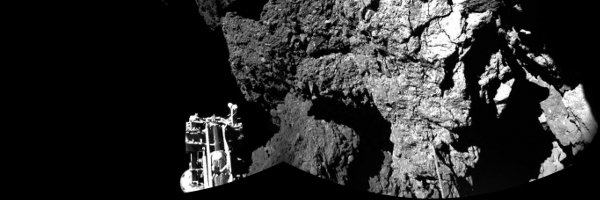
Lander Philae
The 12th of November 2014 was the exciting moment of the space mission Rosetta: The lander Philae was released from the orbiter Philae and reached the surface of comet 67P/Churyumov-Gerasimenko after seven hours of a nearly free fall. Philae is the first lander made by humans that has ever landed on the surface of a comet nucleus. It carries ten scientific instruments aboard that have studied the comet nucleus at close proximity. The exterior of Philae is covered by solar cells supplying the required electricity for the instruments aboard.
During landing, two mechanisms aboard, which should have anchored Philae into the ground, failed, so that the probe did not come to a rest at the intended landing site and continued its way over the cometary surface. Not until two hours later and three more bouncers on the cometary surface, Philae came to a final stop. This landing site proved to be unfavourable: Philae is likely to be strongly inclined to the side and is situated in a hollow or a hole, so that the solar cells receive very little solar radiation for the power generation. The operation of the scientific instruments was only possible by using the on-board batteries, whereas the recharging via the solar cells was not possible at that time. Hence, Philae did work 57 hours at its final landing site and fell into a kind of hibernation thereafter.
The images of the surrounding area of Philae that were taken by the cameras aboard and transmitted back to Earth reveal walls or “cliffs” looking like massive rock faces. They have to consist of water ice. Furthermore, the measurements revealed, the outer layers of the comet nucleus have to be very hard. The mean density of the comet nucleus is only half of the one of water ice which complies with previously investigated comet nuclei. The material of comets has to be very porous and must contain cavities.
Mass spectra that were taken with the MPS manufactured COSAC-instrument reveal a number of organic substances. An attempt at the final landing site has been made to take a soil sample and analyse it with COSAC. This attempt failed possibly due to the missing anchorage of Philae into the cometary surface. During the descent of Philae, the dust particle detector SESAME-DIM measured a several millimetres large dust particle. It was likely very porous which complies with the data taken by the dust instruments aboard Rosetta. At the final landing site of Philae, there was no detection of dust particles which is likely a consequence of the comet’s low activity in proximity to the landing site and possibly a shadowing effect to the detector caused by Philae’s unfavourable position.
The comet Churyumov-Gerasimenko passed the perihelion of its path in August 2015 and reached its highest activity at that time. By approaching the sun, the solar radiation onto the solar cells increased. As a result of the increase in power generation and the increase of the temperature aboard, the on-board computer of Philae reactivated itself. On the 13th of June 2015 the first radio communication could be restored for the first time after seven months. However, this did not enable a renewed operation in the summer of 2015. Since the 9th of July 2015, there is no radio communication with Philae anymore.